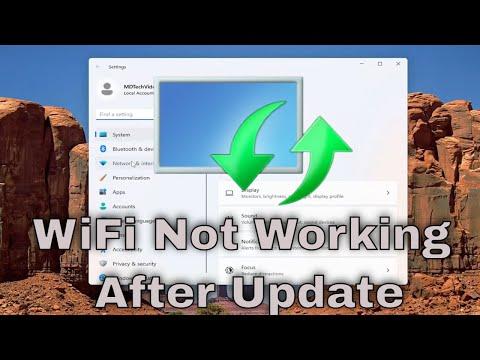It was an ordinary Saturday morning when I decided to update my Windows operating system. I had been putting off the update for weeks, and finally, I figured it was time to ensure my computer had the latest features and security patches. The update process went smoothly, and I didn’t expect any issues. However, when the computer restarted, I was greeted with an unexpected problem: my WiFi connection was not working.
At first, I tried the usual troubleshooting steps. I checked if the WiFi was enabled on my laptop. I went into the network settings and verified that my computer was not in airplane mode. Everything seemed fine on the surface, yet I still couldn’t connect to the internet. I restarted the computer, hoping that it was just a temporary glitch, but the problem persisted.
Next, I decided to check the network adapter settings. I opened the Device Manager and looked for the network adapters section. Everything appeared to be in order; the network adapter was present, and there were no warning icons. I tried to disable and then re-enable the adapter, but that didn’t resolve the issue either.
I then turned to the Windows network troubleshooter. It ran its diagnostics and suggested that there might be a problem with the network adapter driver. This was the first real clue I had about what could be causing the issue. I recalled that updates often include new drivers or changes to existing ones, and this might have interfered with my WiFi functionality.
To dig deeper, I decided to visit the website of my laptop’s manufacturer. I downloaded the latest drivers for my network adapter, thinking that perhaps the update had caused a mismatch between the Windows driver and the actual hardware. After installing the new drivers, I restarted the computer, but my WiFi still wasn’t working.
It was becoming increasingly frustrating. I started researching online to find others who might have encountered the same problem. I found that this issue was relatively common after a Windows update or feature upgrade. Many users had faced similar issues where their WiFi stopped working after an update.
One of the common suggestions I came across was to use the System Restore feature. System Restore allows you to revert your computer’s state to a previous point in time before the update was installed. I decided to give it a try. I accessed System Restore through the Control Panel and selected a restore point from before the update. The process took some time, but once it was completed, I restarted my computer and checked the WiFi connection. Unfortunately, the problem was still there.
Not giving up, I decided to perform a network reset. This is a more drastic measure but can sometimes fix deeper networking issues. I went to the Settings app, navigated to Network & Internet, and selected “Network Reset.” This process removed all network adapters and then reinstalled them. After completing this, I restarted my computer and was hopeful that the issue would be resolved.
The network reset did not fix the problem either. At this point, I realized I needed to dig even deeper. I found forums where tech enthusiasts discussed issues similar to mine and learned about a potential solution involving the Windows registry. It seemed risky, but I decided to proceed with caution.
I opened the Registry Editor and navigated to the following path: HKEY_LOCAL_MACHINE\SYSTEM\CurrentControlSet\Services\WlanSvc. Within this registry key, I checked if there were any settings that might have been altered or corrupted by the update. I made sure to back up the registry before making any changes, just in case.
After carefully adjusting a few settings related to the WLAN service, I restarted my computer once more. To my relief, the WiFi connection finally started working again. The process had been time-consuming and required a lot of trial and error, but it was worth it.
In summary, dealing with WiFi issues after a Windows update or feature upgrade can be quite challenging. My experience showed me that a systematic approach is often necessary. Start with basic troubleshooting steps like checking network settings and restarting your computer. If that doesn’t work, move on to more advanced solutions like updating drivers, using System Restore, or performing a network reset. If all else fails, investigating deeper system settings and configurations, such as the Windows registry, might provide a solution. While these steps might not always resolve the problem immediately, patience and persistence are key.
